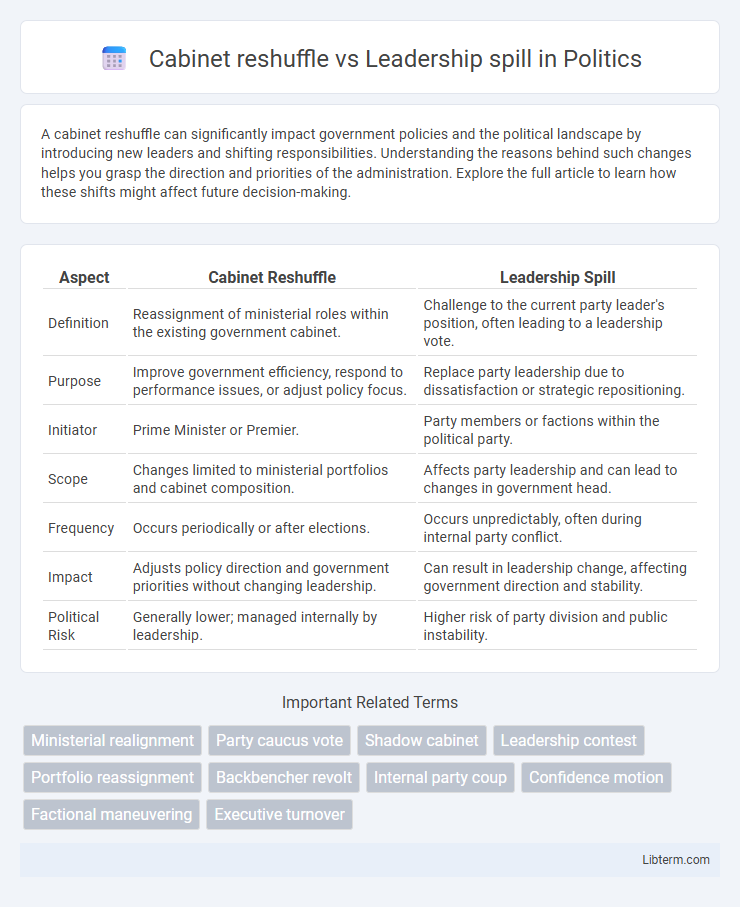A cabinet reshuffle can significantly impact government policies and the political landscape by introducing new leaders and shifting responsibilities. Understanding the reasons behind such changes helps you grasp the direction and priorities of the administration. Explore the full article to learn how these shifts might affect future decision-making.
Table of Comparison
| Aspect | Cabinet Reshuffle | Leadership Spill |
|---|---|---|
| Definition | Reassignment of ministerial roles within the existing government cabinet. | Challenge to the current party leader's position, often leading to a leadership vote. |
| Purpose | Improve government efficiency, respond to performance issues, or adjust policy focus. | Replace party leadership due to dissatisfaction or strategic repositioning. |
| Initiator | Prime Minister or Premier. | Party members or factions within the political party. |
| Scope | Changes limited to ministerial portfolios and cabinet composition. | Affects party leadership and can lead to changes in government head. |
| Frequency | Occurs periodically or after elections. | Occurs unpredictably, often during internal party conflict. |
| Impact | Adjusts policy direction and government priorities without changing leadership. | Can result in leadership change, affecting government direction and stability. |
| Political Risk | Generally lower; managed internally by leadership. | Higher risk of party division and public instability. |
Understanding Cabinet Reshuffles
Cabinet reshuffles involve the Prime Minister or President reorganizing ministerial positions to improve government efficiency or respond to political pressures, often by replacing or relocating key officials. These changes aim to optimize policy implementation and maintain party cohesion without necessarily altering the head of government. Unlike leadership spills that challenge or change the party leader or Prime Minister, cabinet reshuffles focus on adjusting the executive team to address governance challenges and strategic priorities.
Defining Leadership Spills
A leadership spill refers to a challenge initiated within a political party to replace its current leader, often triggered by internal dissatisfaction or poor electoral performance, distinguishing it from a cabinet reshuffle which involves reallocating ministerial roles without necessarily changing party leadership. Leadership spills typically occur in parliamentary systems such as Australia's, where party members vote to confirm or replace the leader. This mechanism plays a crucial role in maintaining party cohesion and can significantly impact government stability and policy direction.
Key Differences Between Cabinet Reshuffles and Leadership Spills
Cabinet reshuffles involve the Prime Minister or head of government rearranging ministerial positions to improve policy implementation or political strategy without changing leadership, typically affecting multiple portfolios. Leadership spills are internal party challenges that can result in changing the party leader or Prime Minister, directly impacting national leadership and often triggered by loss of confidence or political instability. While reshuffles focus on optimizing government functionality, spills target leadership legitimacy and party control within parliamentary systems like Australia and Canada.
Historical Examples of Cabinet Reshuffles
Cabinet reshuffles have been a strategic tool in political history, such as Winston Churchill's 1940 reshuffle to strengthen his war cabinet and Margaret Thatcher's 1989 reshuffle aimed at consolidating power. These reshuffles often realign ministerial roles to respond to political challenges or shift policy direction, distinct from leadership spills where party leadership is contested. Effective cabinet reshuffles can stabilize governments and signal policy priorities without triggering the volatility typical of leadership spills.
Notable Leadership Spill Events
Notable leadership spill events in Australian politics include the 2018 Liberal Party spill where Malcolm Turnbull was replaced by Scott Morrison as Prime Minister, demonstrating internal party disagreement and power shifts. Leadership spills differ from cabinet reshuffles, which mainly involve reallocating ministerial portfolios without changing the party leader. These spills often result in sudden changes at the highest political levels, reflecting significant factional influence and political instability within parties.
Political Motivations Behind Reshuffles and Spills
Cabinet reshuffles often arise from political motivations to maintain party unity, improve governmental performance, or respond to public dissatisfaction by repositioning key ministers. Leadership spills are typically driven by internal party power struggles, where factions seek to depose the current leader to shift policy direction or enhance electoral prospects. Both mechanisms serve as strategic tools to consolidate power, address leadership challenges, and influence political stability within parliamentary systems.
Impact on Party Stability and Governance
A cabinet reshuffle typically aims to enhance party stability by reallocating ministerial roles to address performance issues or political strategy, thereby reinforcing governance efficiency. In contrast, a leadership spill, which challenges the head of government or party leader, often triggers internal conflict and uncertainty, destabilizing party unity and disrupting policy continuity. The impact on governance from a leadership spill is generally more severe, causing potential shifts in government priorities and prolonged administrative instability.
Media Coverage and Public Perception
Media coverage of a cabinet reshuffle typically emphasizes policy changes and government stability, highlighting the strategic motivations behind ministerial swaps. In contrast, leadership spills attract intense media scrutiny framed around internal party conflict and power struggles, often amplifying political drama and uncertainty. Public perception tends to view reshuffles as routine political adjustments, while leadership spills are seen as indicators of deeper party instability and potential shifts in national leadership.
Legal Procedures and Party Rules
Cabinet reshuffles involve formal legal procedures where the Prime Minister or President reassigns ministerial positions within the government, adhering to constitutional mandates and executive protocols. Leadership spills occur within political parties, governed by party rules and constitutions that dictate how leadership challenges and voting processes are conducted among party members. While cabinet reshuffles affect government composition through official state mechanisms, leadership spills are internal party affairs determined by organizational bylaws and membership votes.
Future Trends in Party Leadership Dynamics
Cabinet reshuffles and leadership spills both signal strategic adjustments within party leadership but differ in their implications for political stability and policy direction. Future trends indicate an increase in frequent cabinet reshuffles as parties adapt to shifting policy priorities and public opinion without triggering full leadership contests. Leadership spills may become less common yet more impactful, often catalyzing significant ideological shifts or realignments within parties amid growing internal factionalism.
Cabinet reshuffle Infographic

 libterm.com
libterm.com